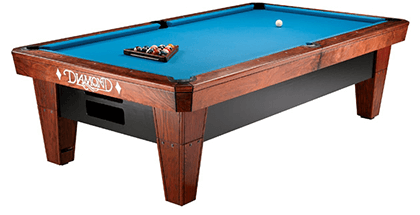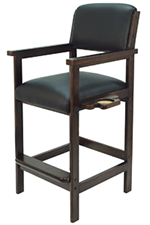The Rules of Play From World Pool-Billiard Association
Except when clearly contradicted by these additional rules, the General Rules of Pocket Billiards apply.
Ten ball is a call shot game played with ten object balls numbered one through ten and the cue ball. The balls are played in ascending numerical order and the lowest numbered ball must be contacted by the cue ball in order to establish a legal hit. The player legally pocketing the ten ball wins the rack, and this can be achieved on the break shot without calling a ball. Only one ball may be called on each shot. (See 9.5 Shots Required to be Called).
9.1 Determining the Break
The player who wins the lag chooses who will break the first rack. (See 1.2 Lagging to Determine Order of Play.) The standard format is to alternate the break, but see Regulation 15, Subsequent Break Shots.
9.2 Ten Ball Rack
The object balls are racked as tightly as possible in a triangular shape, with the one ball at the apex of the triangle and on the foot spot and the ten ball in the middle of the triangle. The other balls will be placed in the triangle without purposeful or intentional pattern. (See Regulation 4, Racking / Tapping of Balls.)

9.3 Legal Break Shot
The following rules apply to the break shot:
(b) if no ball is pocketed, at least four object balls must be driven to one or more rails, or the
shot is a foul. (See Regulation 17, Open Break Requirements.)
9.4 Second Shot of the Rack – Push Out
If no foul is committed on the break shot, the shooter may choose to play a “push out” as his shot. He must make his intention known to the referee, and then rules 6.2 Wrong Ball First and 6.3 No Rail after Contact are suspended for the shot. If no foul is committed on a push out, the other player chooses who will shoot next. The ten ball pocketed during a Push Out is spotted, without penalty.
9.5 Call Shots & Pocketing Balls
Whenever the shooter is attempting to pocket a ball (except the break) he is required to call shots, the intended ball and pocket must be indicated for each shot if they are not obvious. Details of the shot, such as cushions struck or other balls contacted or pocketed are irrelevant.
For a called shot to count, the referee must be satisfied that the intended shot was made, so if there is any chance of confusion, e.g. with bank, combination and similar shots, the shooter should indicate the ball and pocket. If the referee or opponent is unsure of the shot to be played, he may ask for a call.
9.6 Safety
The shooter, after the break at anytime may call “safety” which permits him to make contact with the legal object ball without pocketing a ball and end his inning. However, if the shooter pockets the legal object ball the incoming player has the option to play the shot as left, or hand it back to his opponent. (See 9.7 Wrongfully Pocketed Balls which also applies during a safety.)
9.7 Wrongfully Pocketed Balls
If a player misses his intended ball and pocket, and either makes the nominated ball in the wrong pocket or pockets another ball, his inning has finished and the incoming player has the option to take the shot as is, or hand it back to his opponent.
9.8 Continuing Play
If the shooter legally pockets a called/nominated ball on a shot (except a push out, see 9.4 Second Shot of the Rack – Push Out , any additional balls pocketed remain pocketed (except the ten ball; see 9.9 Spotting Balls ), and he continues at the table for the next shot. If he legally pockets the called ten ball on any shot (except a push out), he wins the rack. If the shooter fails to pocket the called ball or fouls, play passes to the other player, and if no foul was committed, the incoming player must play the cue ball from the position left by the other player.
9.9 Spotting Balls
If the ten ball is pocketed on a foul or push out, or without calling it, or accidentally in the wrong pocket, or driven off the table, it is spotted. (See 1.4 Spotting Balls.) No other object ball is ever spotted.
9.10 Standard Fouls
If the shooter commits a standard foul, play passes to his opponent. The cue ball is in hand, and the incoming player may place it anywhere on the playing surface. (See 1.5 Cue Ball in Hand.) The following are standard fouls at nine ball:
6.2 Wrong Ball First; The first object ball contacted by the cue ball on each shot must be the
lowest-numbered ball remaining on the table.
6.3 No Rail after Contact
6.4 No Foot on Floor
6.5 Ball Driven off the Table; The only jumped object ball that is spotted is the nine.
6.6 Touched Ball
6.7 Double Hit / Frozen Balls
6.8 Push Shot
6.9 Balls Still Moving
6.10 Bad Cue Ball Placement
6.12 Cue Stick on the Table
6.13 Playing out of Turn
6.15 Slow Play
9.11 Serious Fouls
For 6.14 Three Consecutive Fouls, the penalty is loss of the current rack. For 6.16 Unsportsmanlike Conduct, the referee will choose a penalty appropriate given the nature of the offense.
9.12 Stalemate
If a stalemate occurs the original breaker of the rack will break again. (See 1.12 Stalemate.)


 Free Shipping with Tracking on orders over $100 within the Continental USA.
Free Shipping with Tracking on orders over $100 within the Continental USA. 




